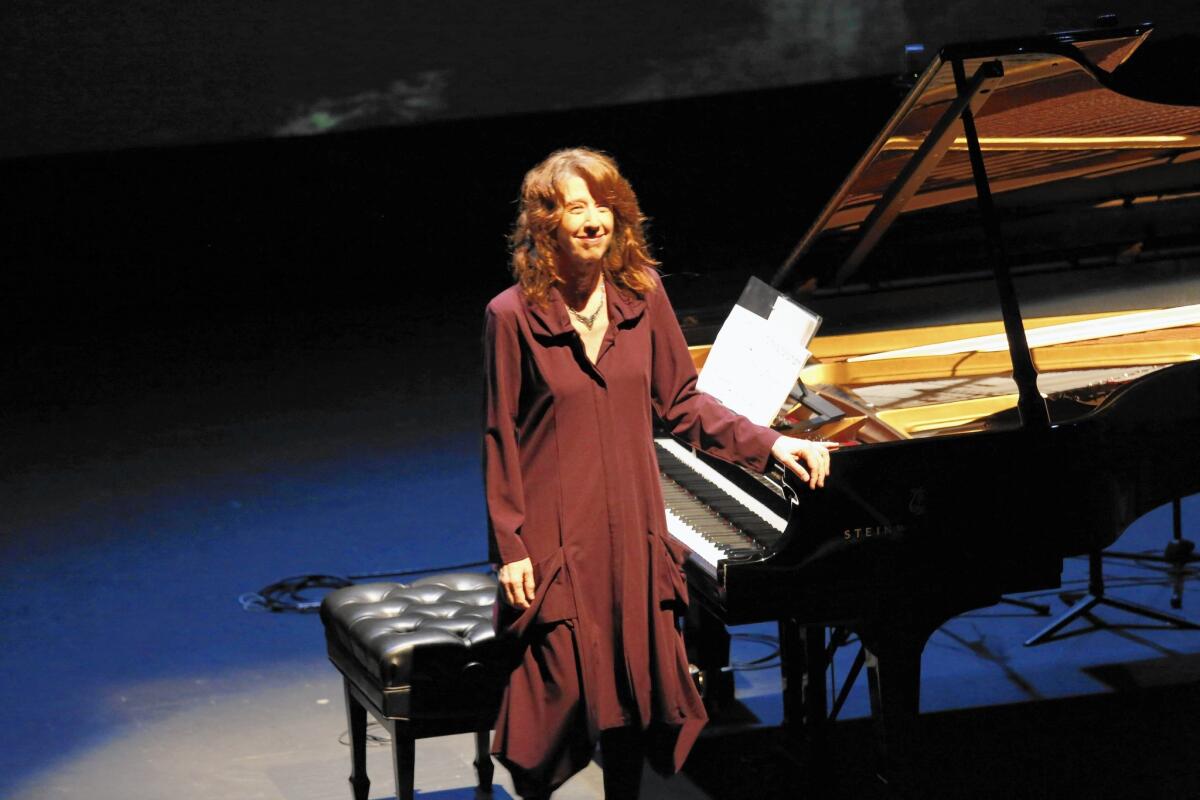Review: The natural elements prove a breeze for Vicki Ray’s Piano Spheres recital at REDCAT

You don’t need a weatherman, Bob Dylan has famously pleaded with us, to know which way the wind blows. But it’s not a bad idea to have a pianist around.
Water, fire, earth and air motivated Vicki Ray’s Piano Spheres recital Tuesday night. “A pianist is forced to spend a lot of time indoors,” she wrote in her program note, and her response has been to try to bring the natural world into the practice room and then, as she did at REDCAT on this occasion, into the concert hall.
Hers is a surprisingly common enterprise, surprising because the piano is no friend of the elements. Water, for instance, can be for a pianist both problem and obsession. Humidity is an enemy of the keyboard, and the evocation of fluidity is a physical impossibility on a percussion instrument over which the player has no control of the sound once the strings are struck or plucked. The pianist’s mission is to create the illusion of one note connecting to the next, artistic magic convincing us that we can hear what physics says we can’t.
SIGN UP for the free Classic Hollywood newsletter >>
Nothing stops pianists. From the start, liquidity was a keyboard ideal, and an ocean of music evoking water has been written over the centuries for harpsichord, clavichord, fortepiano and modern grand. Inspired by Luciano Berio’s 1965 encore piece, “Wasserklavier” (Water Piano), French pianist Hélène Grimaud has a new water-theme CD based on her New York recital last year in which she played in a pool of water as part of an art installation/concert.
“Wasserklavier” was also a motivator for Ray, who began her recital with that and three other elemental Berio encores: “Luftklavier,” “Erdenklavier” and “Feuerklavier,” for air, earth and fire. Ray brought to each a sonic immediacy so that you almost didn’t need to read the program to know which way the wind was blowing. A good thing too because she added tasteful tintype projections of nature photography by Lori Pond that required a darkened room and prevented the audience from easily keeping track of what was being played.
Still, the idea of a pianist needing nature, defying physics and somehow bringing the outside world inside, as the best California architects have done, dominated. Berio’s own motivation for “Wasserklavier” was to show how quotes from Schubert and Brahms might flow, if with an intoxicating consistency of the wine the great Italian composer made on his estate in Siena rather than spring water.
For Toru Takemitsu, water stood for, in the tradition of Japanese art and religious devotion, a wellspring of life. “Rain Coming,” “Rain Spell” and many other of his rain-themed instrumental works would make for a good concert conjuring the delinquent El Niño. Ray turned to Takemitsu’s piano trio, “Between Tides,” written for violinist Pamela Frank, cellist Yo-Yo Ma and pianist Peter Serkin in 1993 yet inexplicably neglected.
Takemitsu’s tides were the ocean that separates East and West. Somewhere in between, harmonies he admired in Duke Ellington are allowed to flow into patterns he learned from traditional Japanese court music or the lush textures he loved in Messiaen. In an attempt to avoid any sense of sogginess, the performance with violinist Sarah Thornblade and cellist Erika Duke-Kirkpatrick was maybe less misty than it might have been, but it nevertheless made a strong case for one of the most alluring piano trios of the late 20th century.
Other than John Luther Adams’ 2007 “Nunataks,” a short sequence of stunning granitic chords, the rest of the program was new. Dominique Schafer’s “Aufwind” (Up-draft) and Mu-Xuan Lin’s “Pale Fire” were Piano Spheres commissions for the occasion by composers, Swiss and Taiwanese, newly relocated to Southern California.
“Aufwind” also needed no weatherman, with thick harmonies in great gusts up and down the keyboard. “Pale Fire” was not about fire but a play on Vladimir Nabokov’s novel of deconstructed poetry transferred to a postmodern realm in which Shostakovich had some connection. At least that’s what the composer’s program note said.
The reality of “Pale Fire” was something more akin to John Cage’s “Water Music,” with a pianist up to all kinds of shenanigans on and around the piano. Electronics were employed. It was not easy to tell whether the equipment manipulated the piano, or the pianist manipulated the electronics. Everything was fragmented. Sounds came before or long after Ray’s hands hit the keys or did whatever it was she did to the strings inside the piano or made vocal sounds. The end result, however, was fascinating.
The other premiere was Ray’s own “Four Elemental Songs,” sumptuously sung by soprano Elissa Johnston and with texts from a variety of sources including a poem by Margaret Atwood and Sanskrit scripture. Here too much of the piano accompaniment was made by Ray’s intriguing fiddling with the strings inside the piano. In each song Ray got the essence of a basic rhythmic or melodic or sonic idea, and each became something to take notice of. The texts, unfortunately, got away from us, as they couldn’t be followed in the darkness.
For an encore, there was one more premiere. In memory of Steven Stucky, the beloved composer who died last week, Ray gave the first public performance of an airy little prelude he had once given her as a gift. In a few wispy phrases, it released an exquisite, otherworldly breeze beyond the scope of any weatherman’s barometer.
More to Read
The biggest entertainment stories
Get our big stories about Hollywood, film, television, music, arts, culture and more right in your inbox as soon as they publish.
You may occasionally receive promotional content from the Los Angeles Times.











